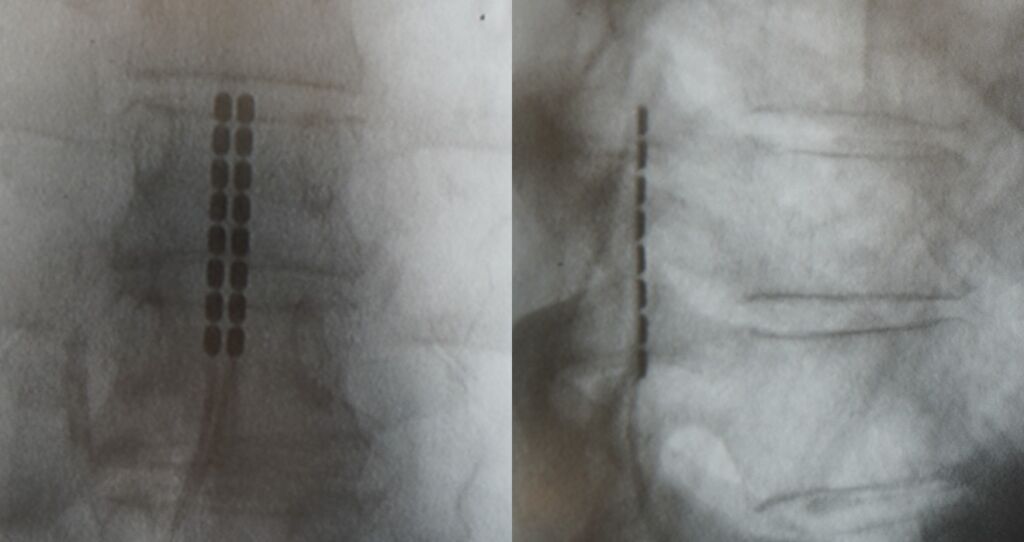Spinal Cord Stimulation
Chronic pain is more common than you think. Even if you don’t suffer from it, chances are you know someone who does. The good news is that the medical arena advances every day. Therefore, people in pain don’t have to go through it alone as there are many available solutions, one of which is spinal cord stimulation.
A spinal cord stimulator, also called a dorsal column stimulator, is an implanted electronic device used to help treat chronic pain. Spinal cord stimulators have been used for over 30 years. The device delivers a low level electrical current through wires, which are placed in the area near your spinal cord. The device is similar in size to a pacemaker.
About Spinal Cord Stmulation (SCS) & The Boston Scientific Difference
SCS therapy can help manage chronic pain — even when other therapies have failed. SCS therapy is:- A non-drug therapy option that has been proven safe and effective.
- FDA-approved for adults with chronic pain of the trunk and/or lower limbs.
- Covered by most insurance plans, including Medicare and most workers’ compensation programs.
- Relied on by hundreds of thousands of people worldwide to help manage chronic pain.
How SCS Works
While SCS is leading-edge technology, it’s actually not as complicated as it seems. Your nerves and brain are constantly communicating with each other. And when you feel pain, it’s because those nerves are sending a pain signal to your brain. That’s where SCS therapy comes in — SCS is designed to interrupt these signals so you don’t perceive them as pain.
What Defines SCS Success?
SCS is generally considered effective:
- If your pain is reduced by at least 50%
- If you are able to get back to your daily activities
- If your need for pain medication is reduced
- If you’re able to relax and sleep better
Who Benefits From Spinal Cord Stimulation?
Almost any nerve injury can develop into a chronic pain issue. Pain presents itself differently depending on the location of the injury. Here are some possible situations where spinal cord stimulation can be beneficial:
- Chronic neck or back pain
- Failed back surgery syndrome
- Complex regional pain syndrome
- Diabetic Neuropathy from unmanaged diabetes
- Muscle or joint injury from an accident or fall
- Arthritis
- Phantom limb pain
As there are many potential causes of chronic pain, treatment options vary according to effectiveness and need. One’s mental health, for example, plays a role in how the patient perceives and handles pain.
Nerve damage can result in periodic throbbing to sharp, shooting pain. Usually, the pain presents itself after spending long hours in a sitting or lying position or even from the simple act of walking up the stairs. If you continue feeling pain and discomfort long after the initial cause dissipates, you might be the perfect candidate for spinal cord stimulation.
Diagnosis
Certain pain origins can be easy to pinpoint, while others might be more challenging. A complete medical history will help your doctor establish the cause. Your doctor will also conduct a physical and neurological exam and perhaps couple that with imaging studies, and minor procedures. Locating the source of the pain is vital to determine the best way to minimize it.

Procedure
Spinal cord stimulation (SCS) is a revolutionary step in managing chronic pain. In this procedure, the doctor places a stimulating electrode on the spinal cord. The aim is to block the pain signals from reaching the brain.
Before the surgery, the patient goes through a trial. This involves the placement of a wire(s) and controlling it externally. With this test, the patient and doctor can determine if the electrical pulse aids in masking the pain signal.
Upon a successful trial, surgery will take place to insert a permanent stimulator. Here, an incision is made on the back and near the waist. The doctor will place a paddle with electrodes in the space behind the spinal cord, the wires are then tunneled under the skin to the waist and connected to a battery-powered generator at the waist.
A hand-held remote will control the implanted device, and depending on the battery type, patients will have to return for replacement every 3 to 5 years.
Potential Risks & Complications
As with all medical procedures, spinal cord stimulation comes with its risks. The most significant drawback is that the therapy might not produce the expected results. A successful procedure will reduce pain by at least 50%.
Common complications relate to unintended movement of the wires, failed connections, or damage to the cables. However, these are reducing with the advancement of technology and surgeons’ skills. A percentage of patients report pain and infections following surgery. Severe effects include bleeding in the epidural space or neurological damage.
If you exhibit the following signs upon returning home, contact your doctor:
- Swelling at the surgical site
- Excessive drainage (changing the dressing every 4 hours)
- Chills
- A fever higher than 100.4 F
OFFICE HOURS
Monday: 8 AM - 4:30 PM
Tuesday: 8 AM - 4:30 PM
Wednesday: 8 AM - 4:30 PM
Thursday: 8 AM - 4:30 PM
Friday: 8 AM - 4:30 PM
Saturday: Closed
Sunday: Closed
PROFESSIONAL DOCTORS
Dr. Schell has designed surgical techniques now used by many spinal surgeons.
MODERN EQUIPMENT
The most up-to-date medical equipment, to give you the best care that you deserve.
Professional spinal care and pain care experts are standing by to assist you. If we are not able to answer your question without an on-site appointment, we can schedule one for you.


